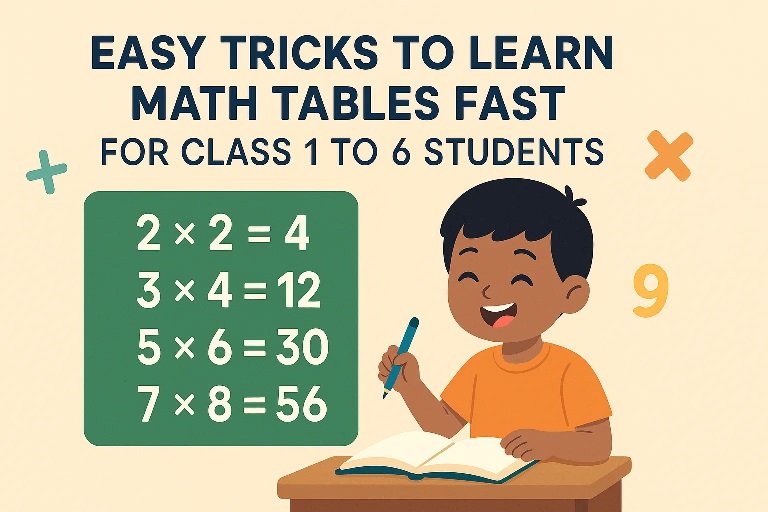For many students in primary classes, learning math tables can feel like a big challenge. But it doesn’t have to be. With the right tricks and a little daily practice, even young learners can master their multiplication tables quickly and with confidence.
In this article, I’ll share simple and effective ways to help children from Class 1 to 6 learn math tables faster, along with tips backed by research and examples that really work in real classrooms.
Why Are Math Tables Important?
Multiplication tables are the foundation of all higher math. They make everyday calculations easier and faster, improve mental math skills, and boost confidence during exams.
A study by Stanford University found that children who were fluent in math tables could solve complex problems 30 percent faster than those who struggled with basic multiplication.
Mastering tables also reduces the fear of math in later years, especially during topics like fractions, long division, and algebra.
When Should Children Start Learning Tables?
Most children begin learning multiplication tables in Class 1 or 2, starting with the 2 times table. By the end of Class 5 or 6, they are expected to know tables up to 20.
Starting early and using the right approach is key to building confidence and speed.
Easy Tricks to Learn Math Tables
1. Use Patterns and Repetition
Children love patterns, and math tables are full of them. For example:
In the 5 times table, every result ends in 0 or 5
The 10 times table just adds a zero at the end
The 9 times table has a fun pattern: the digits in the answers add up to 9 (9, 18, 27, 36…)
Encourage kids to notice these patterns. It makes learning feel more like solving a puzzle than memorizing.
2. Use Rhymes, Songs, and Stories
Turning tables into songs or chants can help children remember them easily. For example:
“Two one is two, two twos are four, two threes are six…” said rhythmically becomes easier to recall.
According to a 2022 study by the University of Cambridge, students who learned multiplication through rhythm or rhyme showed 45 percent better retention after a week.
3. Start with Easy Tables First
Don’t begin with 12 or 13. Start with 2, 5, and 10. These are the easiest and build a strong foundation.
Once children are confident with these, move to 3, 4, and 6, then later to 7, 8, and 9.
4. Use Real-Life Examples
Apply math tables to real life. For example:
“If we have 3 plates and 4 cookies on each, how many cookies in total?”
“If one pencil costs 6 rupees, how much do 4 pencils cost?”
Children connect better when they can see how multiplication works around them.
5. Make it a Game
Turn math tables into a game. Use flashcards, apps, online games, or even oral quizzes with small rewards.
Some popular online resources for learning tables include
Math Playground
SplashLearn
Times Tables Rock Stars
These platforms combine visual learning with fun challenges that motivate students.
6. Practice a Little Every Day
Learning 2 tables a week with daily revision is much better than trying to cram 10 at once.
A 5-minute revision session each day, either orally or written, is more effective than one long session a week.
7. Teach Tricks for Difficult Tables
Here are a few tricks students love:
For 9 times table: Multiply the number by 10 and subtract the number. Example: 9 x 7 = (10 x 7) – 7 = 70 – 7 = 63
For 11: Up to 9, just repeat the digit. Example: 11 x 4 = 44
For 12: Multiply by 10 and add twice the number. Example: 12 x 6 = (10 x 6) + (2 x 6) = 60 + 12 = 72
Learning such shortcuts gives children a feeling of success and curiosity to explore more.
What Parents and Teachers Can Do
Be patient and positive. Avoid pressure or scolding.
Encourage children to speak tables aloud regularly.
Make learning part of daily conversation: counting objects, sharing things equally, etc.
Track progress weekly and reward improvement, not perfection.
My Thoughts
Learning multiplication tables doesn’t have to be boring or stressful. With a mix of fun, consistency, and the right tricks, children can master tables with ease and even enjoy the process.
As parents or teachers, our role is to guide and motivate. Once children feel confident in math tables, you’ll see a noticeable improvement in their speed, interest, and overall math performance.
At IndiaTutor.in, we’re committed to helping every child succeed. Explore our tutor listings and blog resources to find expert guidance and personalized support for your child’s learning journey.
By Nidhi Mehta, Founder, IndiaTutor.in

